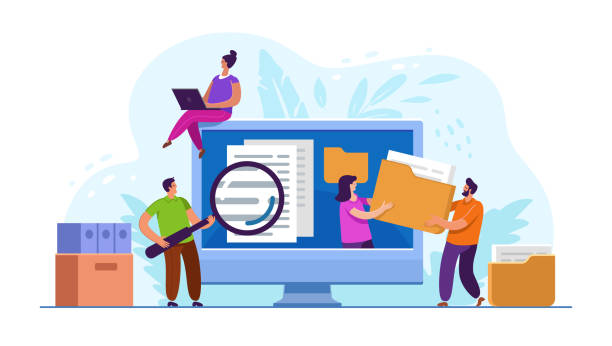Introduction to the Importance of Secure Website Design and Upcoming Challenges

#Secure_Website #Data_Protection #Cybersecurity #Online_Threats
In the current digital age, where a significant portion of our commercial, educational, and social activities are conducted online, secure website design is no longer an option but an undeniable necessity.
Websites are not only business storefronts and communication platforms but also vast repositories of sensitive user information, including personal, financial, and commercial data.
Any security breach can lead to a loss of reputation, heavy financial damages, and violation of user privacy.
The challenges ahead in this field are numerous and complex; from phishing and malware attacks to SQL injection and DDoS attacks, cyber attackers are constantly devising new methods to exploit security weaknesses.
Therefore, understanding the importance of secure website design and implementing strong security standards from the very early stages of development is vital for any organization or individual aiming for a successful online presence.
This section explains the complex nature and dimensions of this topic and highlights the importance of a comprehensive approach in designing and implementing secure websites.
The following educational discussions will introduce you to more details of this process so you can take the necessary steps to protect your digital assets with full awareness.
Are you tired of your e-commerce website not generating as much revenue as its potential allows? RasaWeb, specialized in professional e-commerce website design, solves this problem forever!
✅ Increased sales rate and revenue
✅ High loading speed and unparalleled user experience
⚡ Get free e-commerce website design consultation
Familiarity with the Most Common Website Security Threats

#Cyber_Threats #Web_Vulnerability #SQL_Injection_Attacks #Phishing
In the path of secure website design, a precise understanding of existing security threats is of paramount importance.
Without awareness of these dangers, countering them will be practically impossible.
Among the most common and destructive attacks is SQL Injection, through which attackers can inject malicious SQL commands into the website’s database to access sensitive information or even modify it.
This attack can completely compromise data security and user privacy.
Another very common attack is called Cross-Site Scripting (XSS).
In this scenario, attackers inject malicious code into web pages, which are executed in the victim’s browser and can lead to the theft of cookies, session information, or even modification of page content.
Distributed Denial of Service (DDoS) attacks also take down the website by saturating the server with fake traffic, causing significant financial damage.
In addition to these, phishing, malware, Brute-Force attacks to access administrative panels, and exploitation of software vulnerabilities and incorrect server configurations are other threats that should be analyzed.
Familiarity with these attack methods is the first step in secure website design and implementing effective defense strategies.
This specialized knowledge helps you implement appropriate defense systems and protect your website against these dangers.
Principles of Secure Coding and Best Development Practices

#Secure_Coding #OWASP #Secure_Development #Security_Coding
One of the main pillars of secure website design is adhering to secure coding principles from the very initial stages of development.
Programmers must be familiar with security concepts and techniques to write code that is resilient against cyber attacks.
Standards and guidelines like OWASP Top 10 provide a list of the most common web vulnerabilities that developers should be trained to prevent.
This list includes items such as Injection, Broken Authentication, and XSS-related vulnerabilities.
Implementing strict Input Validation to prevent injection of malicious code and data, using secure functions and libraries, and adhering to the Principle of Least Privilege are among the key methods in this area.
Furthermore, using web development frameworks that have built-in security features by default can significantly help increase security.
Regularly updating project libraries and dependencies is also essential to eliminate known vulnerabilities.
Secure database design, as well as proper Error Handling in a way that does not reveal sensitive system information, are also other important points.
| Vulnerability | Brief Description | Prevention Methods |
|---|---|---|
| SQL Injection | Injecting malicious SQL commands into the database | Using Prepared Statements or ORMs, input validation |
| Cross-Site Scripting (XSS) | Injecting malicious scripts into web pages | Validating and filtering output (Output Encoding), using CSP |
| Broken Authentication | Weakness in authentication mechanisms | Using Multi-Factor Authentication (MFA), strong password hashing |
| Insecure Deserialization | Flaw in processing serialized data | Avoiding deserialization from untrusted sources, monitoring |
The Role of Server and Hosting in Website Security

#Server_Security #Secure_Hosting #SSL_TLS #Firewall
Alongside secure coding, secure website design is highly dependent on server infrastructure and hosting services.
Choosing a reputable and secure hosting provider is the first crucial step.
These providers must adhere to high security standards, including strong firewalls (WAF), intrusion detection and prevention systems (IDS/IPS), and regular data backups.
Correct server configuration is also crucial; closing unnecessary ports, removing extra software, and applying security updates to the operating system and web server (such as Apache or Nginx) are among the essential measures.
Using an SSL/TLS certificate to encrypt communications between the user’s browser and the server is highly important not only for security but also for SEO, providing your website with an HTTPS address that indicates security.
This prevents eavesdropping on sensitive information by attackers.
Furthermore, setting up a VPN for administrative access to the server and restricting access to important files are other specialized measures to strengthen server security.
Managing access and user accounts with the principle of least privilege, and continuous monitoring of server logs to identify suspicious activities are also important tasks in website hardening.
Do you dream of a thriving online store but don’t know where to start?
RasaWeb is your comprehensive e-commerce website design solution.
✅ Attractive and user-friendly design
✅ Increased sales and revenue⚡ Get free consultation
Database Security and Protection of Sensitive Information

#Secure_Database #Data_Encryption #Access_Management #Backup
The database is the beating heart of any website and contains sensitive and vital user and business information.
Therefore, secure website design would be incomplete without special attention to database security.
The first step is to use strong encryption techniques for sensitive data both at rest and in transit.
This ensures that even in the event of unauthorized access to the database, the information remains unreadable.
Access Control to the database is also very important; each user or application should only have access to the minimum information and operations required to perform their task.
Using separate user accounts for different parts of the application and avoiding the use of root or Admin accounts for routine operations is essential.
Furthermore, regularly updating the Database Management System (DBMS) to fix known vulnerabilities and securely configuring it by disabling unnecessary features and changing default ports are other specialized measures.
Regular and secure backup of the database and storing them in a separate and secure location is vital for data recovery in case of any disaster or cyber attack.
Finally, monitoring database activities and identifying abnormal patterns can help detect attacks in their early stages and prevent serious damage.
This explanatory and specialized approach ensures that your valuable data is properly protected in the secure website design process.
The Importance of Authentication and Session Management

#Authentication #Session_Management #Secure_Password #Multi_Factor_Authentication
In the process of secure website design, authentication and session management mechanisms play a vital role in maintaining user and data security.
Strong authentication systems must use complex passwords and powerful hashing.
Storing passwords in Plain Text is a blatant security mistake that can endanger the information of millions of users in case of data leakage.
It is recommended to use one-way hashing algorithms with Salt so that even if the database is stolen, passwords remain unrecoverable.
Implementing Multi-Factor Authentication (MFA), such as sending a code to a mobile phone or email, creates an additional security layer, making unauthorized access to user accounts difficult even if the user’s password falls into the hands of an attacker.
In the session management section, using secure session tokens, limiting session expiration times, and invalidating sessions after user logout or password change are of high importance.
Session tokens must be random and unpredictable to prevent Session Fixation or Session Hijacking attacks.
Enabling the HTTP Strict Transport Security (HSTS) feature also instructs browsers to always use HTTPS communications, which helps prevent Man-in-the-Middle attacks that might reveal session tokens.
All these points must be carefully considered in secure website design to ensure that users can confidently use the website’s services.
Security Audits, Updates, and Continuous Maintenance

#Security_Audit #System_Update #Site_Maintenance #Penetration_Testing
Secure website design is not a one-time process; rather, it requires regular audits, continuous updates, and active maintenance.
Security threats are rapidly evolving, so your website must always remain resilient against these new threats.
Conducting periodic Penetration Testing and vulnerability scans helps identify potential weaknesses before attackers exploit them.
These tests involve simulating real attacks to discover vulnerabilities in the code, server configuration, and network infrastructure.
Regularly updating the operating system, server software, web frameworks, plugins, and all CMS components (such as WordPress or Joomla) is vital to address known security flaws.
Many cyber attacks exploit old vulnerabilities for which patches have already been released.
Establishing a comprehensive maintenance plan that includes reviewing security logs, monitoring unusual traffic, and regularly backing up the entire website and database is essential.
These backups must be stored in secure and separate locations and have quick recovery capabilities.
This analytical and guiding approach ensures that your website remains secure over time and benefits from the latest security technologies and methods, which is a crucial step in maintaining secure and stable website design.
| Activity | Description | Frequency |
|---|---|---|
| Penetration Testing (PenTest) | Simulating attacks to discover vulnerabilities | Annually or after major changes |
| Vulnerability Scan | Automated scan to identify known weaknesses | Monthly or Quarterly |
| Software Updates | Operating System, CMS, Plugins, Frameworks | Immediately after security patches are released |
| Data Backup | Full backup of files and database | Daily or Weekly (depending on data change rate) |
| Log Review | Monitoring server and application logs for suspicious activities | Daily or Weekly |
Incident Response and Data Recovery

#Incident_Response_Plan #Disaster_Recovery #Reactive_Security #Incident_Response
Even with the best approaches to secure website design and continuous maintenance, no website is completely immune to cyber attacks.
Therefore, having an Incident Response Plan and a Disaster Recovery Plan is essential for any organization.
These plans should define clear steps for identification, containment, eradication, recovery, and lessons learned from a security attack.
An effective incident response plan includes forming a specialized team, defining responsibilities, necessary tools for monitoring and detection, and internal and external communication processes.
Upon detection of a breach or security incident, the first step is to contain the situation to prevent further damage.
This can include cutting access to infected systems or isolating parts of the network.
After containment, the attacker must be eradicated from the system, and exploited vulnerabilities must be addressed.
The recovery phase involves restoring systems and data through secure backups and ensuring the website’s proper functioning.
Lessons learned from each incident help improve future secure website design processes and security policies.
This informative and analytical section highlights the importance of preparing for worst-case scenarios and the ability to quickly return to normal after a cyber attack.
Do you dream of a thriving online store but don’t know where to start?
RasaWeb is your comprehensive e-commerce website design solution.
✅ Attractive and user-friendly design
✅ Increased sales and revenue⚡ Get free consultation
Legal and Ethical Aspects of Website Security

#Privacy #GDPR #Data_Security_Laws #Legal_Responsibility
Beyond technical considerations, secure website design requires a deep understanding of the legal and ethical aspects of data protection.
Various laws and regulations exist worldwide to protect user privacy and data security, which websites must comply with.
For example, the General Data Protection Regulation (GDPR) in Europe has set strict standards for the collection, storage, and processing of personal data.
Ignoring these laws can lead to heavy fines and damage to brand reputation.
Websites must have clear privacy policies that inform users how their information is collected, used, and protected.
Furthermore, obtaining explicit user consent for collecting certain types of data, especially sensitive data, is essential.
Ethical responsibility also dictates that website developers and administrators always prioritize user interests and protect their data from misuse.
This includes transparency regarding potential data breaches and timely notification to affected users.
Thought-provoking challenges in this area include the balance between innovation and security, as well as deciding how to handle government requests for data access.
Adhering to these legal and ethical principles not only contributes to secure website design but also earns and maintains user trust.
The Future of Secure Website Design and Emerging Trends

#Future_Cybersecurity #AI_Security #New_Technologies #Quantum_Security
The world of cybersecurity is constantly changing, and secure website design must keep pace with these changes.
Emerging technological trends and new threats present us with new challenges and opportunities.
Artificial Intelligence (AI) and Machine Learning (ML) will play an increasing role in web security, from detecting anomalies and complex attack patterns to automating incident response.
These technologies can significantly enhance websites’ ability to counter unknown threats.
Blockchain-based security also has the potential to create distributed and decentralized systems that are more resistant to tampering and intrusion, although it comes with its own implementation challenges.
With the advent of quantum computing, current encryption may become vulnerable in the future, leading to the need for developing post-quantum cryptography algorithms.
This issue can profoundly impact secure website design in the future.
Additionally, the increased use of the Internet of Things (IoT) and open APIs expands the attack surface of websites and necessitates more comprehensive security approaches.
Engaging discussions around these topics include envisioning websites that are entirely self-defending or platforms that can predict what the next attackers will do using AI.
These trends indicate that the web security profession will never remain static, and continuous learning and adaptation are vital for maintaining secure websites.
Frequently Asked Questions
| No. | Question | Answer |
|---|---|---|
| 1 | What is secure website design? | Secure website design is a process where websites are built with security measures in mind from the initial stages of development to protect against cyber attacks, unauthorized access, and data loss. |
| 2 | Why is secure website design important? | Website security is crucial for maintaining user trust, protecting sensitive information (personal and financial), preventing damage to brand reputation, and complying with privacy and security regulations (such as GDPR). A security breach can lead to financial and legal damages. |
| 3 | What are the most common cyber attacks a website faces? | Some of the most common attacks include SQL Injection, Cross-Site Scripting (XSS), Distributed Denial of Service (DDoS), Brute Force, and credential-based attacks (Credential Stuffing). |
| 4 | What is SQL Injection and how to prevent it? | SQL Injection is a type of attack where an attacker attempts to manipulate the database or extract information by injecting malicious SQL code into site inputs. To prevent it, one should use Prepared Statements/Parameterized Queries, ORM (Object-Relational Mapping), and strict input validation. |
| 5 | What is Cross-Site Scripting (XSS)? | XSS is a type of attack where an attacker injects malicious scripts (usually JavaScript) into web pages, which are then executed by other users’ browsers. This can lead to the theft of cookies, session information, or alteration of the website’s appearance. |
| 6 | How can Brute Force attacks on login pages be prevented? | To prevent Brute Force attacks, one should use CAPTCHA, limit the number of failed login attempts (Account Lockout), Two-Factor Authentication (2FA), and use complex and long passwords. |
| 7 | What is the role of HTTPS in website security? | HTTPS encrypts the communication between the user’s browser and the website server using SSL/TLS. This prevents eavesdropping, tampering, or forgery of information during transmission and increases user trust. |
| 8 | What is the importance of Input Validation in security? | Input validation is the process of checking and sanitizing data entered by the user. This prevents the injection of malicious code, XSS attacks, SQL Injection, and other vulnerabilities, ensuring that the data conforms to the expected format. |
| 9 | Why are regular updates to website systems and software essential? | Regularly updating the operating system, CMS (like WordPress), plugins, themes, and libraries used fixes known security vulnerabilities. Hackers often exploit weaknesses in outdated software to gain unauthorized access. |
| 10 | What role do regular backups play in secure website design? | Regular and tested backups of website data (database and files) are a vital layer of defense against data loss due to cyber attacks, human errors, or hardware failures. This enables quick website recovery in the event of a disaster. |
And other advertising services of RasaWeb Advertising Agency
Smart Brand Identity: A professional solution for campaign management focusing on SEO-driven content strategy.
Smart Social Media: A professional solution for customer acquisition focusing on precise audience targeting.
Smart Brand Identity: Professional optimization for SEO ranking improvement using SEO-driven content strategy.
Smart Social Media: A creative platform for improving SEO ranking by optimizing key pages.
Smart Customer Journey Map: Professional optimization for increasing click-through rates using Google Ads management.
And over hundreds of other services in the field of internet advertising, advertising consultation, and organizational solutions
Internet Advertising | Advertising Strategy | Advertorial
Resources
Web Security: Best Practices and Current Standards
The Importance of SSL Certificate in Secure Website Design
How to Protect Your Website Against Cyber Attacks?
Secure Coding Principles for Web Developers
💡 To reach the pinnacle of success in the digital space, RasaWeb Afarin Digital Marketing Agency is with your business, offering specialized services such as SEO-optimized website design.
📍 Tehran, Mirdamad Street, next to Central Bank, Southern Kazeroun Alley, Ramin Alley, No. 6




